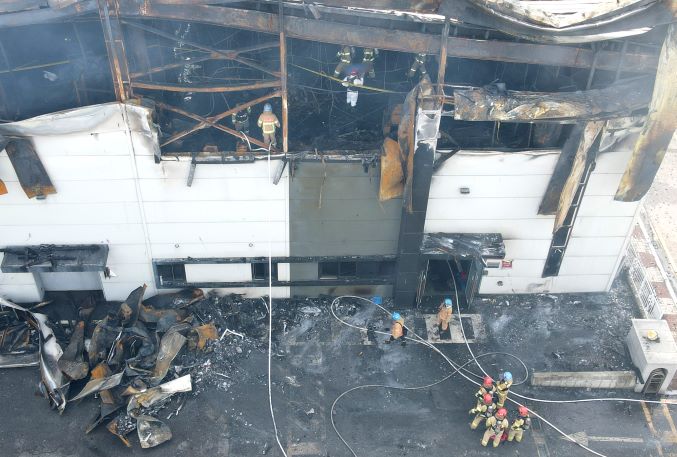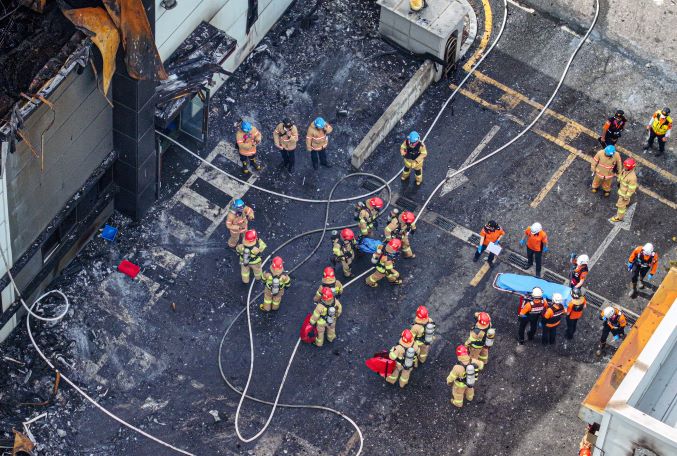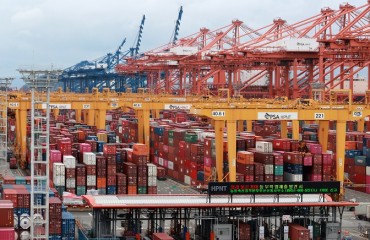
Firefighters retrieve the bodies of workers at the site of a fire at a primary lithium battery factory in Hwaseong, 45 kilometers south of Seoul, on June 24, 2024. The fire reportedly left about 20 workers dead. (Pool photo) (Yonhap)
SEOUL, June 24 (Korea Bizwire) – The lithium battery plant fire that killed at least 22 people in Hwaseong on Monday is likely to go down as the worst chemical plant accident in the country’s history, with experts raising questions about lax safety measures as the cause of the disaster.
Firefighters are still searching for survivors eight hours after the blaze started at lithium battery maker Aricell’s plant in Hwaseong, 45 kilometers south of Seoul, at around 10:30 a.m.
Of the 102 people confirmed to have been working in the three-story building where the fire broke out, 23 people were unaccounted for, including 20 foreign nationals, according to firefighters.
Around 20 bodies were found, presumably of the missing people, after one worker was found dead earlier in the day. Several others sustained injuries.
Chemical plants are particularly vulnerable to large-scale accidents due to the highly flammable nature of the chemicals they handle.
Similar accidents have occurred in various parts of the country in the past, with one of the worst being the LG Chem plant explosion in Yeosu, 316 kilometers south of Seoul, in 1989. That accident resulted in the deaths of 16 people and 17 others being injured.
In 2011, three workers died and five others were injured in the explosion of oil mist at an HDC Hyundai EP plant in the southeastern city of Ulsan, while in 2012, eight people were killed and around 10 injured after a chemical solvent drum can exploded at an LG Chem plant in the central city of Cheongju.
Given their wide distribution, with many located inside industrial complexes nationwide, and their often small-scale operations, chemical plants have been a site of tragedies annually, and sometimes multiple times a year, despite regular safety inspections carried out by the government and related agencies.
Chemical plant accidents also require strict follow-up measures as toxic material released in fires or explosions can cause secondary damage to neighboring areas.
Lithium-ion batteries, in particular, are known to be deadly in case of fire, because they set off a “thermal runaway” process in which increased temperature releases energy that in turn further increases the temperature.

Firefighters retrieve the bodies of workers at the site of a fire at a primary lithium battery factory in Hwaseong, 45 kilometers south of Seoul, on June 24, 2024. The fire reportedly left about 20 workers dead. (Pool photo) (Yonhap)
Conventional fire extinguishing methods are rarely enough to put out such fires, as while the fire may appear extinguished from the outside, the batteries are still hundreds of degrees hot on the inside, which can easily spark another fire.
The lithium battery plant that caught fire Monday was reportedly storing mostly primary batteries, which pose a lower risk of fire than lithium-ion batteries that are rechargeable.
Still, even primary batteries can be dangerous as lithium in general is highly reactive to air and heat. Around 35,000 lithium batteries were reportedly being stored inside the plant at the time of the fire.
“A fire in one electric car will take three hours to put out by throwing water on it, so with the amount of lithium batteries storied at this plant, it has to be extremely difficult to put out the fire,” said Kong Ha-sung, a professor at Woosuk University’s Fire and Disaster Prevention Department.
“More and more sectors of society are using lithium, so a response strategy has to be drawn up with special care,” he said.
Some observers questioned whether the large number of casualties in Monday’s fire was caused by lax safety measures, drawing parallels with other disasters in recent years.
Last year, 14 people were killed when an underground roadway in the central town of Osong flooded during heavy rain. Authorities were accused of failing to properly control traffic on the roadway and bungling their response to emergency calls.
The 2022 crowd crush in Itaewon, which left 159 people dead, was also considered a man-made disaster.
The government launched an industrial disaster response team shortly after Monday’s fire to determine the exact circumstances that led to the accident.
(Yonhap)






